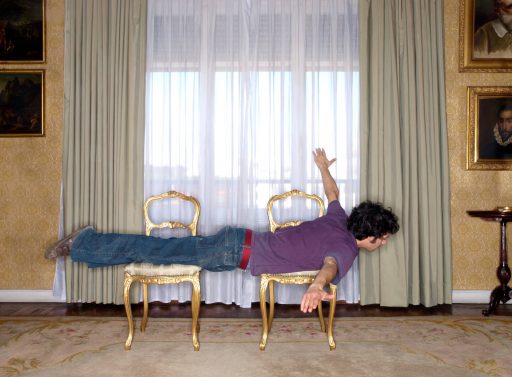How To Have A Midlife Crisis — 2008/2009
In María Platero´s images there is an underground river of corrosive surrealism. It is not oneiric surrealism, it is about confronting with soft irony, objects that change the meaning of the settings, of the landscapes.
A parallel universe is generated. It is as if we sneak into Alice´s other side of the mirror. Things seem logical, because they are subject to another logic. The images are like the illustrations of children´s stories, of metaphors of our childhood. Luminous flashes of childhood, with which fortunately we can still enjoy.
There is a constant duality, which remains on the edge of an inverted world, a parallel world, a hidden world, on the reverse side of the coin, on the other hidden side of the moon.
Human figures seem to be larger than the frame that inhabits them, while they are lost and helpless. The objects have left the figures orphaned of meaning. Inevitably we have to grow and face the days and things.
In the pool, a man measures his strength, puzzled, before a pink float.
At the crime scene, a plunger is the murder weapon. And in that other world, there may be crimes on pink couches, and the carpet is riddled with wavy black lines, and yet there is no body of crime.
In the supermarket, the man with the basket on his head buys up to his head, or locks it up, but is lost among stealthy, innocent but lurking canned food. It looks like a hunter, hunted.
In the lake scene, the man in the briefcase with the canoe on his head refers us to the fabulous images of hybrid beings such as those in El Bosco’s paintings, and sometimes to Goya´s Caprices.
— Carmen Dalmau
Project granted with the Region of Madrid Artistic Creation Award in 2008.
How To Have A Midlife Crisis — 2008/2009
En las imágenes de María Platero hay un río subterráneo de corrosivo surrealismo. No es el surrealismo onírico, es el enfrentarse con suave ironía del hombre a objetos que cambian el significado de los escenarios, de los paisajes.
Se genera un universo paralelo. Es como si nos coláramos con Alicia en el otro lado del espejo. Las cosas parecen lógicas, porque están sometidas a otra lógica. Las imágenes son como las ilustraciones de cuentos infantiles, de metáforas de nuestra infancia. Destellos luminosos de infancia, con los que afortunadamente, aún podemos gozar.
Hay una constante dualidad, que permanece en la orilla de un mundo invertido, un mundo paralelo, un mundo oculto, del reverso de la moneda, de la otra cara oculta de la luna.
Las figuras humanas parecen ser más grandes que el marco que las habita, al tiempo que están perdidas y desvalidas. Los objetos han dejado a las figuras huérfanas de significado. Inevitablemente tenemos que crecer y enfrentarnos a los días y a las cosas.
En la piscina, un hombre mide sus fuerzas, perplejo, ante un flotador rosa.
En la escena del crimen, un desatascador es el arma homicida. Y en ese otro mundo, es posible que haya crímenes sobre sofás rosas, y la alfombra esté surcada por onduladas líneas negras, y sin embargo no hay cuerpo del delito.
En el supermercado, el hombre con la cesta en la cabeza compra hasta su cabeza, o la encierra, pero está perdido entre sigilosas conservas inocentes, pero acechantes. Parece un cazador, cazado.
En la escena del lago, el hombre del maletín con la piragua en la cabeza nos remite a las imágenes fabulosas de seres híbridos como los de los cuadros de El Bosco, y a veces a los Caprichos de Goya.
— Carmen Dalmau
Proyecto premiado con el Premio de Creación Artística de la Comunidad de Madrid 2008.













